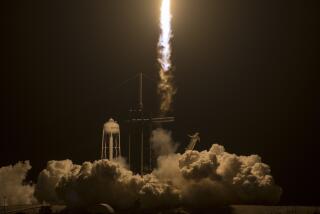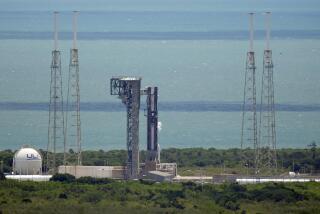Hubble device fails; repair mission delayed
- Share via
An instrument that stores and transmits science data back to Earth has broken down on the Hubble Space Telescope, forcing NASA on Monday to postpone a long-scheduled repair mission to the ailing, 18-year-old telescope.
The 136-pound control unit and science data formatter, which separates data from the telescope’s five major science instruments into packets for transmission to scientists on Earth, broke down Saturday night, according to NASA scientists.
Attempts to reset the ice-chest-size device and dump the stored data were unsuccessful, leaving the instrument unable to perform the tasks it had smoothly carried out for nearly two decades.
“All of our efforts . . . totally failed,” Preston Burch, manager of the Hubble program at the Goddard Space Flight Center in Greenbelt, Md., told reporters Monday evening.
Burch said scientists at Goddard were trying to understand what went wrong but so far had come up empty.
“We do not know the precise location and nature of the failure,” Burch said.
The instrument operates at high temperature, something that could accelerate the degradation process. Long-term exposure to radiation in space could also have played a role, the scientists said.
The failure came as NASA was finalizing an Oct. 14 repair mission to the telescope, the fourth since Hubble was launched in 1990.
Over five spacewalks, astronauts from the space shuttle Atlantis were scheduled to install an ultraviolet spectrograph and a new wide-field camera, as well as repair failed electronics on the Space Telescope Imaging Spectrograph and the Advanced Camera for Surveys.
They also planned to attach a new set of gyroscopes.
Officials said Monday that that repair would be delayed until at least February, giving the shuttle repair crew time to train on installing a backup formatter.
As frustrated as he was by the new problems, Ed Weiler, associate administrator of NASA’s Science Mission Directorate, said if the unit was going to fail it was better that it fail before the repair mission rather than after.
While NASA studies a revamped repair mission, Burch said engineers at Goddard will probably make an attempt in the next few days to switch to a redundant set of controls that could bring the unit back to full operability.
The changeover is not as simple as throwing a switch, however, because multiple other instruments will also have to be commanded to make new connections to the formatter.
If it works, NASA will gain breathing space to plan and train for the new repair mission.
Every month that mission is delayed costs NASA about $10 million.
If all goes well with the complete set of repairs, Hubble’s new capabilities will easily surpass those it was intended to have at the time of its launch.
The repair mission has been controversial, however, because if anything goes wrong, the astronauts will be in the wrong orbit to reach the haven of the International Space Station.
Concerns over astronaut safety have been a key issue since the loss of the shuttle Columbia in 2003. Former NASA Administrator Sean O’Keefe originally canceled the repair mission, deeming it too risky.
It was only reinstated after Congress allocated the money for the repair and required that it be spent on nothing else. Current NASA Administrator Michael D. Griffin believed the repair could be done safely and eventually gave the go-ahead.
Griffin has stated repeatedly that this will be the final repair for Hubble, conceivably giving it five or six more years of service before it breaks down for the last time. When that happens, it will be allowed to reenter Earth’s atmosphere and burn up.
--
More to Read
Sign up for Essential California
The most important California stories and recommendations in your inbox every morning.
You may occasionally receive promotional content from the Los Angeles Times.










